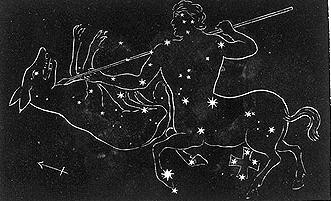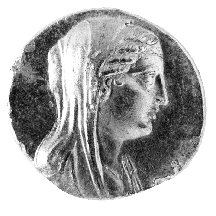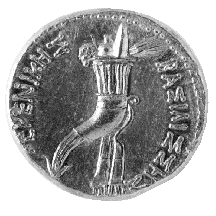The Classical Non-Zodiac Astrological Constellations
Definition: [Constellations] The stars of the non-zodiac astrological Constellations of classical astrology, as described by Claudius Ptolemy in Tetrabiblos Book i Chapter 9. [For the Zodiac stars follow this link.] [See the Mainz Globe for drawings of the constellations from the time of Ptolemy.]
|
In Tetrabiblos, the the most important text in the history of astrology, Claudius Ptolemy [c 130 - 170 AD] makes the following, fascinating, statement: "We shall decline to present the ancient method of prediction, which brings into combination all or most of the stars... [as] it depends much more upon the particular attempts of those who make their inquiries directly from nature..." [Tetrabiblos Book iii Chapter 1] Just what that ancient method was Ptolemy gives us no clue, leaving for us one of the greatest mysteries of astrology. [Though I, for one, am convinced that the solution lies in the Galactic Zodiac]. However, in Tetrabiblos, Ptolemy at least lists the powers of the non-zodiac "fixed stars", though he gives us no clue as to how to apply them. Such stars are usually grouped together as either the stars or bright stars of a Constellation. Occasionally, however, different stars in different parts of the figure of a non-zodiac Constellation have different powers. These include the stars in the constellations of: Boötes, the Herdsman, Canis, the dog, Centaurus, the Centaur, Eridanus, the River, Orion, the Hunter, and Perseus, the Hero. For example, the powers of the stars of Centaurus, Ptolemy noted, differ if they are located in the "human body" part of the centaur, or the horse part of that Constellation. [Further details of the powers of the stars of these constellations are given below.] Stars in different parts of the figure of a Solar Zodiac Constellation always have different powers - see for example Capricornus. The powers themselves are described by Ptolemy as being the same as those of six of the seven planets known to the Classical astrologers. They include the powers of the Moon. No star is ever described as having the same powers as the Sun. Some Constellation's stars, for example those in Ara, the Altar, have powers akin to more than one planet, occasionally with the second planet in a lesser degree. Uniquely, the stars of Draco, the Dragon, have powers similar to three different planets, perhaps because this is an exceptionally large and long Constellation. Shown in the table below are all the non-zodiac Classical constellations, along with their meanings, the star types Ptolemy described and the planetary powers the stars possessed. |

Non-zodiac Constellations. Pictured in Atlas portatalis coelestis, Johann Rost, Nuremberg, 1723. In the sixteen centuries between Ptolemy and Rost many Constellations were added to the skies, which would not have been recognised by the Ancient Greeks. There are now 88 accepted constellations instead of Ptolemy's 48. Many of these are southern hemisphere constellations, like those pictured above. From his observatory in Alexandria, Egypt, Ptolemy would never have been able to see the circumpolar areas of the southern skies. From the plate above only the Argo Navis, the Swift One, and Piscis Notius would have been familiar to him. Piscis Notius is better known as Piscis Austrinus, the Southern Fish. [Some invented Constellations have not made it to the official 88. Robur Carolinium - King Charles' Oak - named in 1678 by Edward Halley for Charles II of England - is not one of the 88 modern Constellations.] |
The Classical Greek Non-Zodiac Constellations and their Powers:
| Constellation | Meaning | Star Type* | Planetary Equivalence |
| Andromeda | the Princess | stars | Venus |
| Aquila | the Eagle | stars | Mars, Jupiter |
| Ara | the Altar | stars | Venus, Mercury [lesser degree] |
| Argo Navis [i] | the Swift One | bright stars | Saturn, Jupiter |
| Auriga | the Charioteer | bright stars | Mars, Mercury |
| Boötes | the Herdsman | bright stars - | Mercury, Saturn |
| bright, tawny star, Arcturus - | Jupiter, Mars | ||
| Canis | the Dog | the bright star in the mouth - | Jupiter, Mars [lesser degree] |
| the other stars - | Venus | ||
| [Canis Minor] [ii] | the Lesser Dog | the bright star Procyon - | Mercury, Mars [lesser degree] |
| Cassiopeia | the Queen | stars | Saturn, Venus |
| Centaurus | the Centaur | the ones in the human body - | Venus, Mercury |
| the bright stars in the equine body - | Venus, Jupiter | ||
| Cepheus | the King | bright stars | Saturn, Jupiter |
| Cetus | the Whale | bright stars | Saturn |
| Coma Berenices [iii] | Berenices Hair | the star cluster, beneath the Bear's tail | Moon, Venus |
| Corona Australis | the Southern Crown | bright stars | Saturn, Mercury |
| Corona Borealis [iv] | the Northern Crown | stars | Venus, Mercury |
| Corvus | the Crow | stars | Mars, Saturn |
| Crater | the Cup | stars | Venus, Mercury [lesser degree] |
| Cygnus | the Swan | stars | Venus, Mercury |
| Delphinus | the Dolphin | stars | Saturn, Mars |
| Draco | the Dragon | bright stars | Saturn, Mars, Jupiter |
| Equuleus | the Little Horse | bright stars | Mars, Mercury |
| Eridanus | the River | the last bright star - | Jupiter |
| the other stars - | Saturn | ||
| Hercules [v] | the Demi-God | stars | Mercury |
| Hydra | the Water Snake | bright stars | Saturn, Venus |
| Lepus | the Hare | stars | Saturn, Mercury |
| Lupus | the Wolf | bright stars | Saturn, Mars [lesser degree] |
| Lyra | the Lyre | stars | Venus, Mercury |
| Orion | the Hunter | the stars on his shoulders | Mars, Mercury |
| the other bright stars | Jupiter, Saturn | ||
| Pegasus [vi] | the Winged Horse | ||
| Perseus | the Hero | stars - | Jupiter, Saturn |
| cluster in the hilt of the sword - | Mars, Mercury | ||
| Piscis Australis | the Southern Fish | the bright star in the mouth | Venus, Mercury |
| Serpens | the Serpent | stars | Saturn, Mars |
| Sagitta | the Arrow | stars | Mars, Venus [lesser degree] |
| Triangulum | The Triangle | stars | Mercury |
| Ursa Major | The Great Bear | bright stars | Mars |
| Ursa Minor | the Little Bear | bright stars | Saturn, Venus [lesser degree] |
|
* From Ptolemy's
text
it is difficult to tell if he makes a serious distinction between stars and
bright stars.]
|
An AV octodrachm, c 246-221 BC It shows the head of Berenice II, wife of Ptolemy III Euergetes (Benefactor) reigned c 246-222 BC. It is this Berenice for whom the constellation Coma Berenices is said to have been named. Obverse: Diademed and veiled head of Berenice II, wearing necklace. Reverse: Cornucopia bound with diadem. Coin portraits of queens were common in Hellenistic Egypt, where women had higher status than elsewhere in the ancient world and were often influential. Berenice is depicted with the royal diadem and a veil. The fruit-filled cornucopia bound with the royal diadem of the reverse is a symbol of abundance and prosperity often depicted on the coins of agricultural Egypt. |
Examples of the Classical Greek Non-Solar-Zodiac Constellations and the Powers of their Stars:

Boötes, the Herdsman. from Hyginus -Poeticon Astronomicon. De mundi et sphaerae ac utriusque Partium declaratione cum planetis et variis signis Historiatis, Melchior Sessa & Pietro Ravani, Venice, 1517. [This was the first printed version of Hyginus' work]
|
Boötes, the Herdsman: Ptolemy tells us that the stars have the powers of Mercury and Saturn. That is except for the "bright, tawny star, Arcturus," the Bear Guard, alpha Boötis. This star possesses the powers of Jupiter and Mars. On the figure shown to the left, Arcturus is the largest star shown next to the left of the body of the Herdsman. Melchior Sessa & Pietro Ravani's figure is not a good representation of how the Ancients saw Boötes. It is a good example of how knowledge was lost down the centuries from Ptolemy's time. In 1517, Western Europe was only beginning to rediscover Classical astrology. As noted in Ptolemy's Informatae, Ptolemy's additional information to his Al Magest Star Catalogue, Arcturus, star 110, was normally located by the Ancients, between the legs of the figure of Boötes. "Quae est inter crura et vocatur Arcturus subrufa" Arcturus is one of only nine stars given a name by Ptolemy in his Catalogue. |
|

Canis Major, the Greater Dog. From Uranometria, Johann Bayer, Augsburg, 1603 AD. Columba, the Dove, is below Canis Major.
|
Canis, the Dog: Ptolemy tells us that the stars of Canis have the powers of Venus. That is except for the "bright star in the mouth," which possesses the powers of Jupiter - and those of Mars to a lesser degree. From the description of star 818 in Canis Major in Ptolemy's Al Magest Star Catalogue, "Quae in ore fulgentissima est, et vocatur Sirius, et est subrufa," the bright star in the mouth is Sirius, the Scorcher. Sirius is a star with a long astrological lineage, known to have been important as far back as the Ancient Egyptians, to whom it represented the god Anubis. 
Canis Major, the Greater Dog. Detail from Atlas Coelestis, Johann Doppelmayr, Nuremburg 1742 AD.
|
|

Centaurus, the Centaur. from Coelum stellatum Christoph. Semler, Magdeburg, 1731. Centaurus is shown with his spear through Lupus, the Wolf. Crux Australis, the Southern Cross - a modern Constellation - is visible beneath Centaurus.
|
Centaurus, the Centaur: Ptolemy tells us that the stars "in the human body" of the centaur have the powers of Venus and Mercury. The brightest star in the human part of the figure is Menkent, the Shoulder of the Centaur. However, the bright stars in the equine part of the body of the centaur have the powers of Venus and Jupiter. These include - in the front two hooves - Rigil Kentaurus, the Foot of the Centaur, and Hadar, beta Centauri . Rigil Kentaurus is better known now as alpha Centauri, the closest star system to Earth. Ptolemy and the Classical Greeks considered the stars now called Crux Australis, the Southern Cross, as part of Centaurus, and so would have included Acrux, the bottom star of the cross as having the powers of Venus and Jupiter.
|
|
Eridanus, the River. From Firmamentum Sobiescianum sive Uranographia, Johannes Hevelius, Gdansk, 1690 AD. Click on the above picture for a larger version 130 kB.
|
Eridanus, the River: Ptolemy tells us that the stars of Eridanus have the powers of Saturn. This is with the exception of the last bright star, which possesses the powers of Jupiter. In Al Magest Star Catalogue Ptolemy gives the starting point of Eridanus as next to the Constellation of Orion, the Hunter. The constellation then runs south, with Ptolemy's last bright star, "Ultima fluvii et est splendida," being star 805, theta Eridani, later known as Acamar. This is from the Arabic for the End of the River. It is thought that for the Ancient Greeks Acamar was the southern most star that was visible in the Constellation. However, after Ptolemy's time travelers who journeyed further south found that the Constellation continued as far south as the bright star, Achernar, which now marks the offical end of the Constellation.
|
|
Orion, the Hunter. From Atlas Coelestis, John Flamsteed, London, 1753 AD. Click on the above picture for a larger version 185 kB [with Taurus].
|
Orion, the Hunter: Ptolemy tells us that the bright stars have the powers of Jupiter and Saturn. The exception to this is the stars on Orion's shoulders, which have the powers of Mars and Mercury. The two bright stars of the shoulders of Orion form the upper parts of what is usually the most recognisable Constellation in the winter skies of the northern hemisphere. Ptolemy in Al Magest Star Catalogue names neither of these stars. The names we have for them are from Arabic: the star of the left shoulder is Bellatrix, the Female Warrior, and the star of the right is Betelguese, the Armpit! To the Ancient Egyptians the figure of Orion represented the god Osiris.
|
|

Perseus, the Hero. From Atlas coelestis, Johann Gabriel Doppelmayr, Nuremberg, 1742. Perseus is shown holding the head of Medusa.
|
Perseus, the Hero: Ptolemy tells us that in general the stars of Perseus, the Hero, have the powers of Jupiter and of Saturn. The exception to this is the "cluster in the hilt of the sword". In the Doppelmayr figure of 1742 [shown left] this cluster is difficult to make out. However, from Al Amagest, Ptolemy was referring to the nebulas now called h Persei and Χ Persei, [NGC 869 and NGC 884] a famous double cluster in the Milky Way. It is star 191 in Ptolemy's Al Magest Star Catalogue, described as, "Quae in dextrae manus extremitate et est." It is the first star that Ptolemy notes in the Constellation. In Tetrabiblos, Ptolemy tell us this cluster has the powers of Mars and Mercury. From Ptolemy's description, this figure from 1742, which is facing away from us is incorrect. Perseus of the Ancient Greeks faced towards us, sword in his right hand, Gorgon head held in left. The sword and head are, however, in the correct places. This sort of mistake was common in the early star maps. For example, some Ophiuchus star maps show other instances of similar mistakes.]
|
The Real Solar Zodiac Sun Signs:
| Sun Sign | Meaning | Dates | |
| 01: | Pisces | the Fishes | 12 Mar to 18 Apr |
| 02: | Aries | the Ram | 19 Apr to 13 May |
| 03: | Taurus | the Bull | 14 May to 19 Jun |
| 04: | Gemini | the Twins | 20 Jun to 20 Jul |
| 05: | Cancer | the Crab | 21 Jul to 9 Aug |
| 06: | Leo | the Lion | 10 Aug to 15 Sep |
| 07: | Virgo | the Maiden | 16 Sep to 30 Oct |
| 08: | Libra | the Scales | 31 Oct to 22 Nov |
| 09: | Scorpius | the Scorpion | 23 Nov to 29 Nov |
| 10: | Ophiuchus | the Serpent Bearer | 30 Nov to 17 Dec |
| 11 | Sagittarius | the Archer | 18 Dec to 18 Jan |
| 12: | Capricornus | the Sea Goat | 19 Jan to 15 Feb |
| 13: | Aquarius | the Water Carrier | 16 Feb to 11 Mar |
| * | The Non-Zodiac Constellations | ||
© Dr Shepherd Simpson, Astrological Historian
Historical Astrology
See the new Astrological Index for the meaning of other astrological words and phrases



